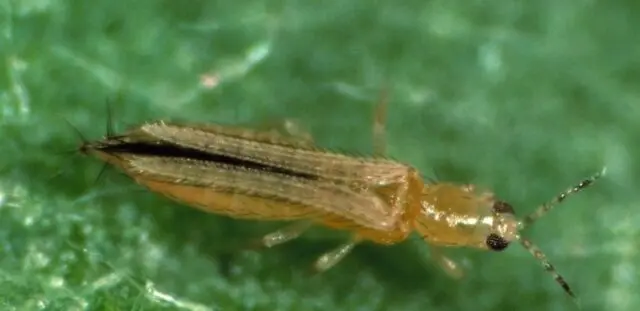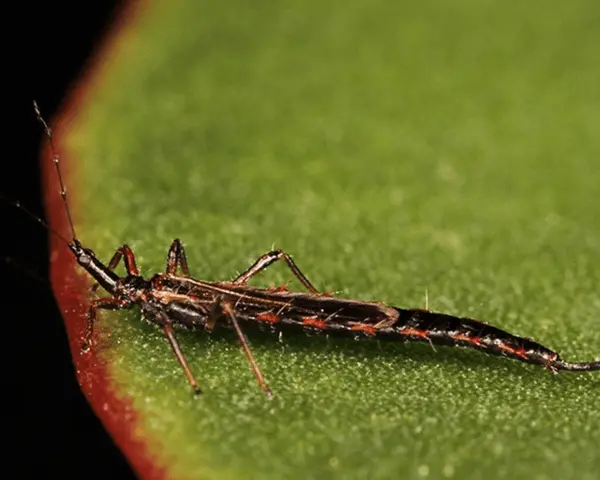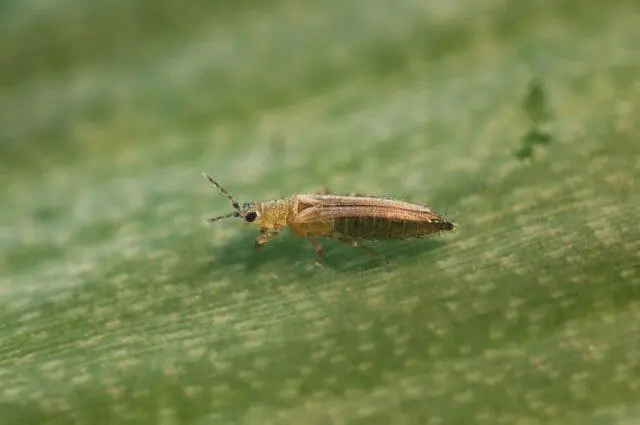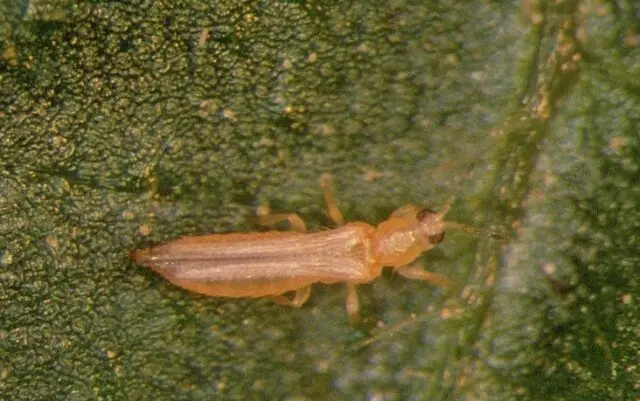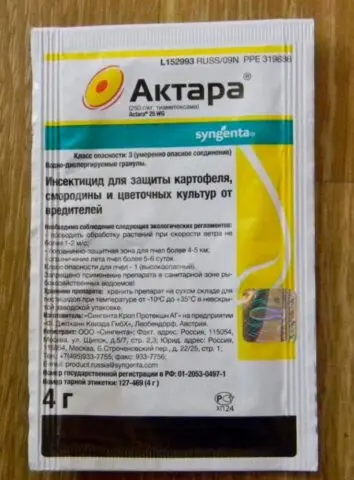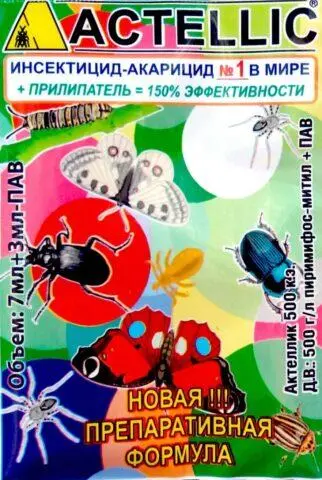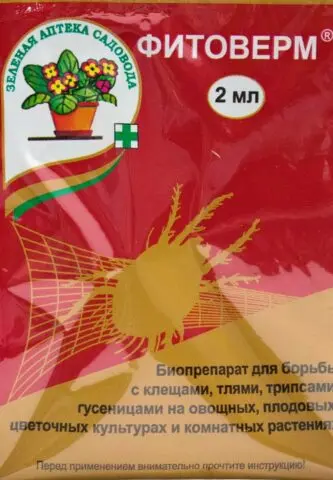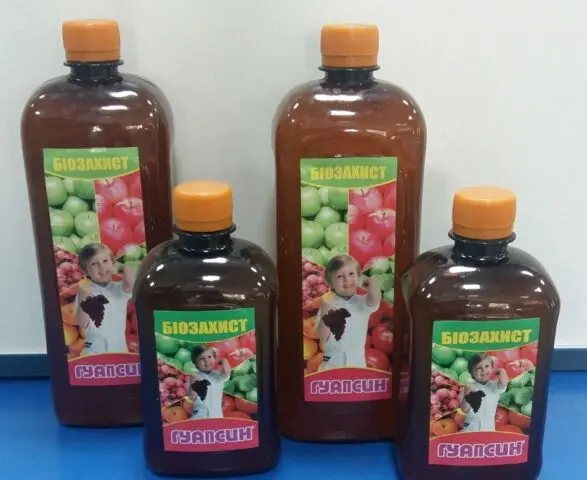Contents
Thrips on tomato seedlings can appear regardless of the type and variety of the crop. These harmful insects cause significant damage to tomatoes, and if you do not start fighting them in a timely manner, you can be left without a crop at all. To prevent this, every gardener must know how to identify the pest in a timely manner. And you should also familiarize yourself with the basic measures of protection and prevention of damage.

Thrips lead a secretive lifestyle.
Description of the pest
Thrips are small insects, the size of which does not exceed 3 mm. They belong to the order Fringed-winged. The pest has an elongated body and a cone-shaped head. The color of insects is black, gray, brown, depending on the species.
Female insects are larger in size than males. They are able to fly, and on their narrow wings there is a fringe of cilia. The larvae look the same as the adults, only smaller and without wings.
Insects have three pairs of legs, which are equipped with special teeth and bubble suckers. This allows them to easily hide and hold on to the underside of the tomato leaves. The mouth apparatus of thrips is of the sucking type.
The females of the pest are particularly fertile. At a time, they lay up to 300 eggs, from which voracious larvae hatch after 10-12 days. Insects hide in the root system, buds, flowers and under the leaves.
Types of thrips
Tomatoes can suffer from several types of thrips. There is no significant difference between pests, except for their preferences in nutrition and color.
Types of thrips that affect tomato seedlings:
- polyphagous (Frankliniella intotonsa);

The polyphagous type affects flowers and ovary
- California or flower (Frankliniella occidentalis);

Californian is a carrier of tomato bronze virus
- rose (Thrips fuscipennis);

Rosanna lives in buds
- tobacco (Thrips tabaci);

Tobacco is distributed throughout the world
- bulbous (Liothrips vaneeckei).

Bulbous most commonly found on gladioli and lilies
Causes of appearance
The appearance of thrips on tomato seedlings is promoted by elevated temperature. Therefore, thrips can mainly be found on tomato seedlings grown on a windowsill or in a greenhouse with irregular ventilation.
Other provoking factors;
- lack of preventive treatment of soil, planting material;
- acquisition of infected seedlings;
- non-compliance with crop rotation;
- density of landings;
- lack of timely top dressing;
- the proximity of other crops that also suffer from thrips.
What does tomato seedlings affected by thrips look like?
The danger of this pest is that it is very difficult to recognize the lesion at the initial stage. Thrips are able to successfully hide in one bud or under a certain leaf for the first time. And only later, with mass reproduction, signs appear that indicate a lesion:
- openwork light mesh on the leaves;
- sticky discharge on shoots, plates, flowers;
- general dejected appearance of seedlings;
- deformation of the tips of the shoots;
- slow development.
What harm can
Thrips, feeding on the cell juice of tomatoes, significantly weaken them and reduce resistance to diseases. Also, their vital activity disrupts the process of photosynthesis in the leaves, which negatively affects the overall development of seedlings. The leaves dry out, the shoots are deformed, the flowers and the ovary crumble.
Thrips are also dangerous because they are carriers of viral diseases. In this case, the affected seedlings must be dug up and burned to prevent further spread of the infection.
How to deal with thrips on tomato seedlings
To get rid of thrips on tomato seedlings is possible only with complex measures. They include chemical and biological preparations, as well as folk remedies. But in order for the treatment to be successful, you need to follow the rules for their use.
Chemical preparations for thrips on tomatoes
These tools help to quickly reduce the number of pests. They should be used to spray seedlings when characteristic signs of damage appear. The peculiarity of chemicals is that they can be addictive in pests. And for repeated treatments, you should use products with different active ingredients.
Chemical preparations begin to work two hours after treatment. They cause paralysis, and subsequently the death of adults and larvae. But the active ingredient does not penetrate through the egg shell. Therefore, it is necessary to process seedlings of tomatoes from thrips at intervals of seven days, until the signs of their vital activity completely disappear.
Active chemicals:
- Aktara;

Aktara should be used for watering and spraying seedlings
- Fufanon;

Fufanon belongs to the category of chemicals of the third hazard class
- Actellic.

Aktelik requires extra precautions
Biological agents
You can also treat tomatoes from thrips with biological preparations. Their peculiarity is that they do not contain pesticides. Such products do not pose a danger to the environment. But they have a delayed destructive effect on thrips.
The best biologics:
- Fitoverm. This preparation is obtained on the basis of the waste products of soil microorganisms. It protects plants not only from thrips, but also from ticks, aphids. The drug begins to act 3-4 hours after treatment, and causes the death of pests on 3-4 days.

Fitoverm can not be used when flowering tomatoes
- Aktofit. The drug was created on the basis of avermectins, which are natural specific neurotoxins. It has a contact-intestinal effect. For the destruction of pests, 10 ml of the product must be dissolved in 1 liter of water. Processing is carried out in the morning or in the evening.

Aktofit causes the death of thrips two days after application
- Guapsin. This biological product has insecticidal and fungicidal properties. Before use, it must be diluted with water in a ratio of 1:40. The visible result becomes noticeable after two days

The duration of the protective action of Guapsin is seven days.
Folk remedies
These methods of control are effective with a small number of pests, as well as for the prevention of damage. Folk remedies have a deterrent effect on thrips, due to the sharp saturated smell.
From pests on tomato seedlings help:
- Marigold. Against thrips, an infusion of this plant should be used. To prepare it, you need to pour 50 g of marigold flowers into 1 liter of water. Then you need to bring the mixture to a boil and set aside. Infuse the remedy for three days, and then strain and spray the seedlings with it.
- Lemon. To prepare an effective remedy, you need 150 g of citrus peel. It needs to be finely chopped and add 10 g of garlic, crushed to a mushy state. Then mix the resulting mixture with 1 liter of water and boil for a quarter of an hour. After that, cool the product, strain and spray it with tomato seedlings.
- Tar soap. The smell of this detergent is also disgusting to thrips. To combat the pest, grate 100 g of tar soap, add 1,5 liters of hot water, mix well. After cooling, strain and dilute with water in a ratio of 1 to 2. Spray the seedlings and the top layer of soil with the resulting product.
Preventive measures
You can protect tomato seedlings from thrips if you follow simple preventive measures. They cannot completely eliminate such a possibility, but they minimize it.
Basic preventive measures:
- treatment of the substrate and seeds before planting;
- timely picking of seedlings;
- proper feeding of seedlings to maintain a high level of immunity;
- compliance with the rules for caring for tomatoes;
- spraying folk remedies.
Conclusion
Thrips on tomato seedlings are a common occurrence, and therefore the sooner a gardener discovers a problem, the less damage they will cause to seedlings. Since given the fertility of this pest, any delay can lead to the death of plants. Therefore, it is important to regularly inspect the leaves of the seedlings for pests in order to prevent the mass reproduction of thrips.











